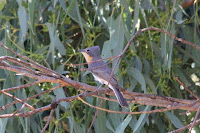The air is full of birdsong at Swinging Bridge Reserve, Wee Jasper. "Song" is not always apt when much of the "noise" is coming from the large parrot population. Sulphur-crested cockatoo, King parrots, Crimson rosella and Galah were the most obvious during our visit last week. Yellow-tailed black cockatoo and Gang-gang (although not seen on this occasion) are also regular visitors.
 |
| Australian King parrot (male above, immature below) |
 |
| Immature Crimson rosella |
 |
| Rufous whistler were actively singing .... err ... whistling! A constant joy! |
 |
| The penetrating piping of White-throated treecreeper added some further charm. |
 |
| Yellow-faced honeyeater was the predominant honeyeater species and leant its frequent brisk call to the chorus. |
 |
| My first thought was that this was an immature Black-chinned honeyeater but it has been pointed out that Brown-headed honeyeater is a much better fit - Excellent - a lifer! A review of Pizzey suggests that there are five honeyeater species with that familiar white nape and paler front. Of these I am yet to see the Strong-billed honeyeater endemic to Tasmania. |
The Leaden flycatcher buzzing calls added a different dimension as did the
Satin bowerbirds at their bower. Noisy friarbird were ..... well, noisy! Kookaburras provided a daily (or twice daily) chorus. When I first heard roosting Australian wood ducks calling ("gnaaaaw") I wondered if I was listening to a broken kookaburra that couldn't get going!
 |
| Australian wood duck - We don't really "quack" |
Large numbers of Superb fairywren led the small bird voice accompanied by White-browed scrubwren. Diamond firetail provided an occaisonal finchy flavour.
All in all a most pleasant and amazing soundscape!
Bird on!
















Pete
ReplyDeleteWhen were the images taken? I'm particularly interested in the Black-chinned HE as they have only once been recorded in the ACT (not too far from Wee Jasper).
Martin
Last week Martin, but see below.
DeletePete
ReplyDeleteIt has been suggested that this is an adult Brown-headed Honeyeater which would be much more likely in that area. On thinking about it further I tend to agree and wonder why you rejected that species?
Martin
Hi Martin,
DeleteThanks for your interest. Brown-headed is a much better fit! Not so much "rejected" as not even aware of its existence! Another learning experience and a lifer for me - thanks.
Peter
Pete
DeleteGood stuff. Always pleased to help!
Martin
I'm probably a bit late to the party here but your Brown-headed Honeyeater is most definitely just that, a Brown-headed Honeyeater. It is the only member of the genus that has an eye ring that completely encircles the eye.
ReplyDelete